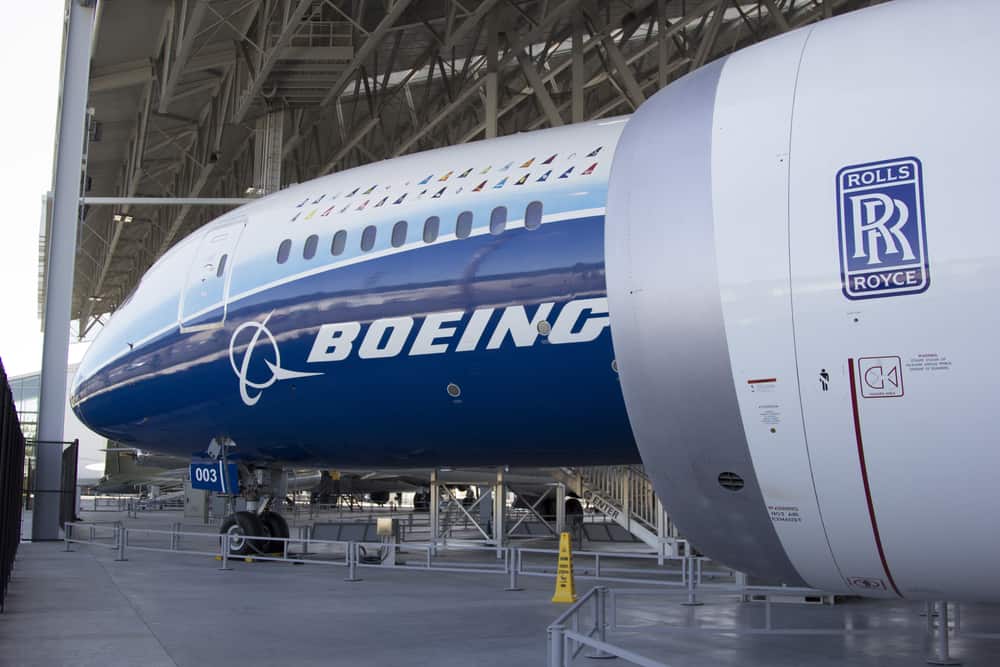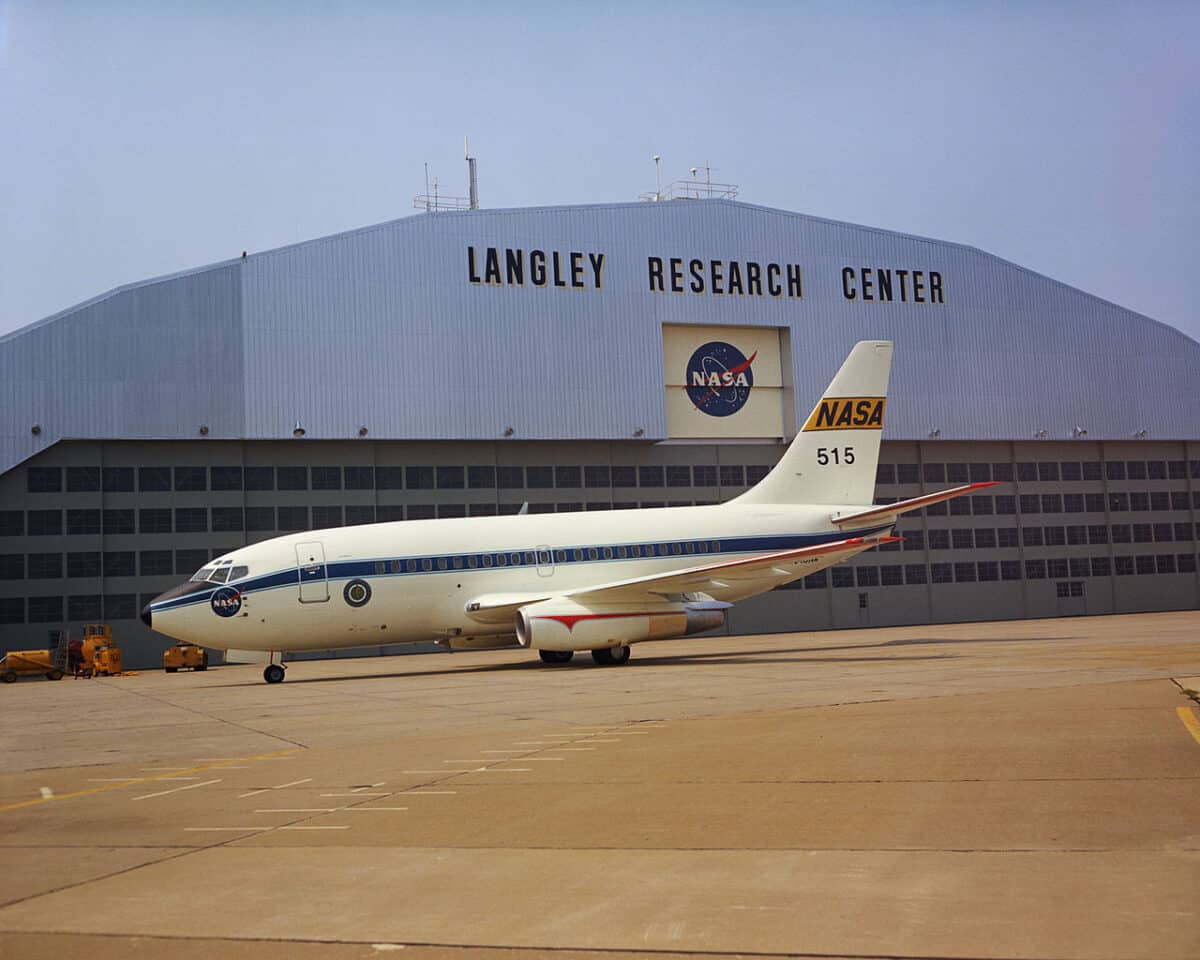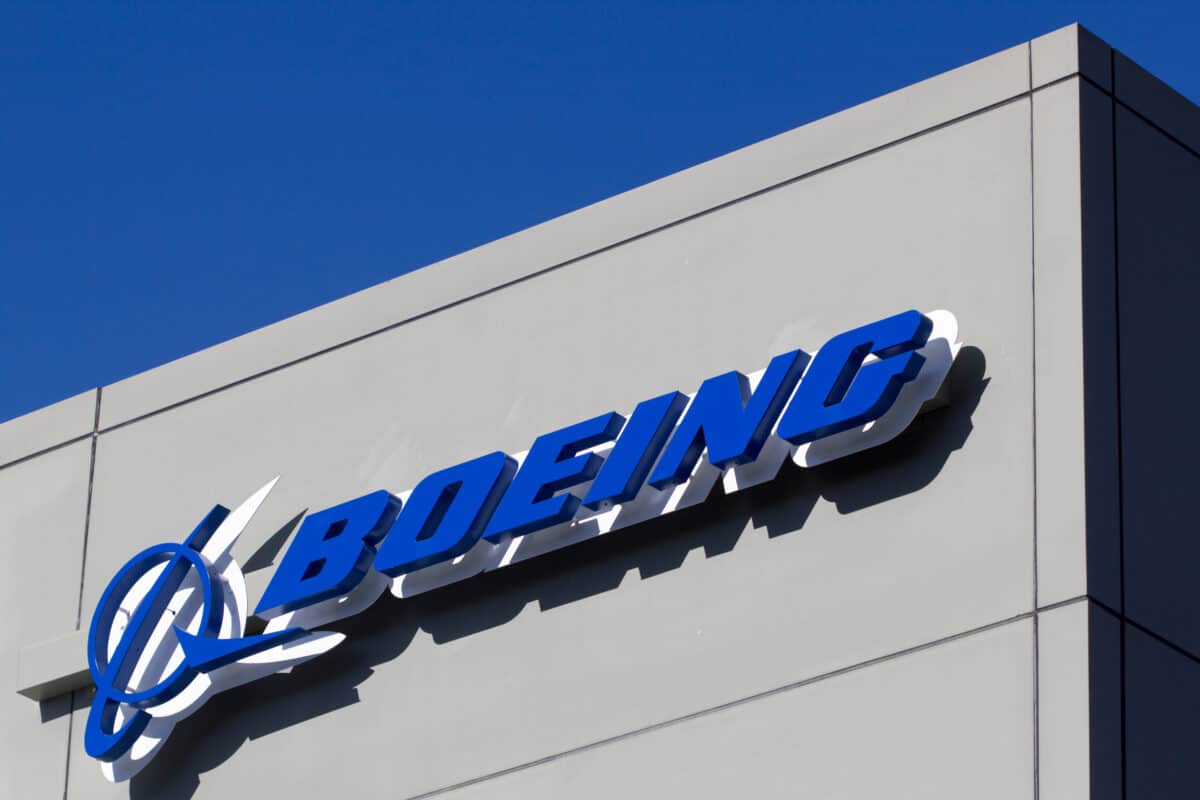NASA is working on the Artemis Program, which aims to send astronauts back to the Moon. To achieve this monumental feat, the space agency contracted Boeing, a reliable rocket manufacturer, to build the launch vehicle.
The Space Launch System (SLS) is set for its first mission in late 2022.
However, this isn’t the first rocket Boeing has built for NASA. This storied company watched its contribution to the Saturn V send astronauts to the lunar surface for the first time.
With a century of experience in the industry, aerospace owes a considerable amount of gratitude to Boeing for its contributions.
Continue reading for the complete history of this prominent government contractor.
The History of Boeing: What to Know

.
©Alex JW Robinson/Shutterstock.com
Boeing is an international aerospace and defense contractor with its headquarters located in Chicago, IL. The company manages the design and manufacturing of airplanes, rockets, satellites, and other aeronautic equipment.
It employs over 140,000 people and has an annual revenue of $62 billion. With over 100 years of experience, no other aerospace company can claim influence as large as Boeing.
Boeing started business in 1916 under the name Pacific Aero Products Co. In its 106 years of operation, the aeronautics manufacturer has produced nearly 400 models of commercial aircraft, over 200 military aircraft, and two satellites. They have acquired over 30 companies in the fields of aviation, robotics, IT, and more.
The defense contractor has had a hand in many of the United States’ aerospace innovations.
Among its immense list of products, Boeing is especially recognized for its development of:
- Boeing 737
- Saturn V S-IC first stage
- B-2 stealth bomber
- International Space Station
- Space Launch System (as ULA)
Boeing’s reputation as one of the United State’s primary defense contractors comes with some controversy. The company is known for aggressive business tactics, including the espionage of its competitors. Most recently, the aeronautics manufacturer has come under fire for shoddy craftsmanship in its planes, which may have led to two fatal crashes in 2018-19.
The Founding of Boeing: How It Happened
Before William E Boeing made his start in aviation, he was a lumber entrepreneur in Seattle, OR. His excitement for airplanes sparked in 1909 after seeing one in action at the Alaska-Yukon-Pacific Exposition that year. The businessman promptly learned to fly from the greatest in the country at the time and seven years later he founded Pacific Aero Products Co.
Boeing began production out of an old Boatworks in Seattle. With his experience in lumber, he was able to convert the Boatworks into wooden parts manufacturing for planes. His models didn’t find customers at first, but when the United States entered WWI in 1917, the US Navy ordered 50 of Boeing’s Model 2s.
While demand for planes quickly dropped following the end of the war, Boeing had made an impression. The federal government contracted the airplane manufacturer to build a fleet of mail carriers that would deliver from coast to coast. By the time of WWII, Boeing was one of the country’s prominent aeronautics contractors.
Boeing Through the Decades
1910s
Almost immediately after its inception, Boeing started selling its Model 2s to the US government in WWI. With experience in the lumber industry, the airplane manufacturer had access to top-of-the-line wood components.
Following the war, the company again used its experience to supplement business. For years while airplane sales halted, Boeing switched to building furniture and other wooden products.
1930s
Boeing’s experience in WWI awarded the company government contracts to build main carriers. The manufacturer moved from wood to all-metal aircraft and led the industry.
Their presence was so prominent that congress prohibited them from flying mail. This resulted in a major scandal, with the company splitting into smaller entities and William E Boeing leaving.
1960s

©NASA, Public domain, via Wikimedia Commons – Original / License
Following the launch of the USSR satellite Sputnik in 1957, the US government founded the National Aeronautics and Space Administration (NASA). Dubbed the “Space Race”, the United States and the USSR aggressively attempted to demonstrate their interstellar prowess.
After President John F. Kennedy announced that the US would land a man on the moon, Boeing was contracted to build the first stage of the Saturn V, which would become the largest rocket ever built.
While they were building space launch systems, Boeing continued to develop its airplanes. In 1967, the manufacturer introduced the 737. Having improved their mail carriers’ capacity immensely, this mid-scale airliner could transport up to 130 passengers. The 737 became the best-selling commercial aircraft in history.
1990s
With Boeing’s unprecedented success with its commercial airliners, the manufacturer grew exponentially. The company started changing its infrastructure, acquiring Rockwell Aerospace and Defense. They also merged with McDonnell Douglas, another prominent aerospace contractor.
The merger was too big, however, and led to volatile company culture. Boeing went under fire for unethical business policies, which included corporate espionage and poor manufacturing.
2000s
Boeing continued to manufacture successful aircraft as it entered the next Millenium, but it failed to compete against competitors Lockheed Martin and Airbus for new contracts. The company started to turn its gaze toward spaceflight technology, offering its services to NASA to build parts for the International Space Station.
In 2006, Boeing partnered with Lockheed Martin to form the United Launch Alliance, which is the country’s largest provider of rocket launch services.
2010s-Present
The airplane manufacturer’s reputation for quality aircraft dropped steadily as they turned their focus toward space. Boeing received contracts from NASA to transport astronauts to the ISS. with a new, reusable spacecraft in development, the manufacturer started acquiring up-and-coming spaceflight companies.
They are currently building NASA’s newest launch vehicle, the Space Launch System. It is set for its first launch to the moon later this year.
What Are the Most Important Inventions from Boeing?
Boeing 737

Boeing develops modern satellites that are used by internet service providers and mobile companies.
©Tada Images/Shutterstock.com
Boeing designed the 737 airliners in 1967. The narrow-body vehicle features two underwing turbofans and has the capacity for up to 215 passengers. The 737 was the most successful aircraft in history, outselling all of its competition until the Airbus A320 surpassed it in 2019.
Saturn V
NASA contracted Boing to build the S-IC stage of the Saturn V rocket in 1961. The S-IC first stage was 138 feet tall and weighed nearly over 300,000lbs before fuel. The S-IC was used for 13 launches from 1967 to 1973 and helped transport astronauts to the moon.
B-2 Stealth Bomber
A joint project of many of the country’s leading defense contractors, Boeing had a hand in designing many of the B-2 components. The stealth bomber went on to become one of the most successful infiltration vehicles in US history.
Space Launch System
Boeing’s spaceflight reputation has brought the company to design the Space Launch System (SLS), NASA’s newest super-heavy launch vehicle. The SLS comes following the announcement of the Artemis Program, which aims to send humans back to the moon. The SLS will launch its first test flight around the celestial body in late 2022.
How Does Boeing Make Money?
As one of the world’s largest aerospace manufacturers, Boeing makes most of its money through commercial and military contracts. The company builds and sells aeronautic, spaceflight, and weapons system technology for the US Department of Defense and international buyers.
In 2021, Boeing recorded annual revenue of $62.3 billion. However, the company currently has total equity of -14.8 billion. This suggests that despite the company’s massive gains, it carries with it a substantial amount of debt.
Boeing Acquisitions
McDonnell Douglas
Founded in 1967, McDonnell Douglas was Boeing’s largest competitor in commercial airliners. The two companies merged in 1997 under the Boeing name, and many of McDonnel Douglas’s airplane models were rebranded. Despite the merger, the two companies clashed, which led to many cases of unethical business practices.
Hughes Space and Communications Company
One of the major aerospace contractors in the United States, Hughes sold its space and communications sectors to Boeing in 2000. The companies worked closely to help develop parts for the International Space Station.
North American Aviation
North American Aviation has a long history of spaceflight development. The company was the main contractor for the Saturn V second stage, the Apollo command and service module, and the Space Shuttle orbiter. The company merged with North American Rockwell in 1967, which was eventually sold to Boeing in 2001.
Boeing Notable Controversies
737 MAX Grounding
To keep up with the Airbus A320, Boeing updated their historic 737 models. The 737 MAX first saw service in 2016; with updated engines and aerodynamic changes, it was set to replace the 737 Next Generation. However, after only two years of use, a 737 MAX crashed on a Lion Air flight, killing 189 passengers.
Four months later a second 737 MAX crashed on an Ethiopian Airlines flight, killing another 157 passengers. The Federal Aviation Administration (FAA) permanently grounded the model following the two fatal incidents.
Darleen Druyun Scandal
Darleen Druyun was a civilian official of the Air Force before she came on as an executive for Boeing in 2003. Druyun, with her past connections in the Air Force, hastily pushed an overpriced contract onto the government agency.
However, critics cited the vastly expensive agreement, which caused an investigation of Druyun. In 2004, she pleaded guilty to inflating the price of the contract to benefit Boeing and was sentenced to nine months in federal prison.
Corporate Foul Play
In 1998, Boeing allegedly paid former Lockheed Martin employee Kenneth Branch to disclose nearly 30,000 pages of confidential research documents. Boeing used the documents to win the Evolved Expendable Launch Vehicle competition, along with nearly 70% of the associated launch contracts.
Lockheed Martin sued Boeing in 2003 for the espionage, which resulted in the company losing seven of its contracts and forbidding them from bidding on future contracts for two years.
Boeing: Further Reading
For more information on Boeing’s contributions to space exploration, check out the articles below.
- The 10 Most Powerful Rockets Ever Built – Learn how Boeing influenced the powerful rockets that shaped the spaceflight industry.
- The 10 Largest Space and Exploration Companies in the World – A list of companies seeking to explore and widen our knowledge of the cosmos.
- NASA: The Complete History – The history behind the world’s best-known spaceflight agency.
What is the Artemis Program? Everything You Need to Know – Boeing is working with NASA to send astronauts back to the moon. See what the program entails.